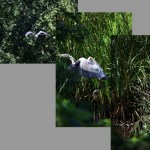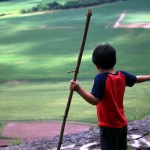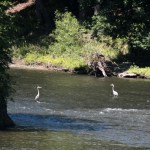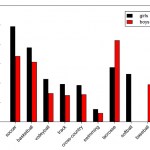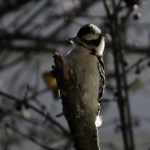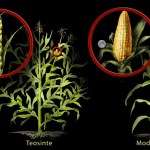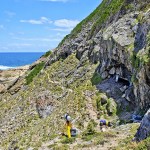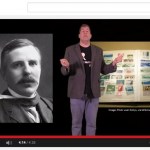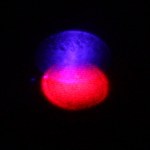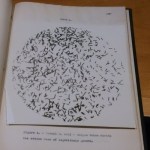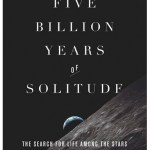Life Science
Another in the sadly delayed wrapping-up of my photo-a-day project. These are all pictures from a hike in the Vischer Ferry Nature Preserve over in Clifton Park. We took the kids over there one time, but a thunderstorm started coming in before we got very far. While the kids were at my parents', I decided to go over one afternoon and take a more thorough walk around the place. This ended up going quite a bit longer than I had expected, as I misremembered part of the trail map, but I got some good photos out of it.
344/366: Fake Jungle
Part of the old Lock 19 from the Erie Canal, cosplaying…
A while back, I went down to Vroman's Nose in Middleburgh to go for a hike, and found a sign saying that peregrine falcons are known to nest on the cliffs. Since the peregrine falcon is SteelyKid's absolute favorite bird, and the subject of her school research project, this seemed like a good location for a family hike, so I took the kids down there yesterday. And even though that was really only one day out of a whole week, I got a bunch of really good photos from it, so it will supply all the material for this week's photo dump.
300/366: Panorama
Panorama of farmland from the top of Vroman…
Another week, another batch of photos. This is coming on Friday rather than the weekend because I'm going to be incommunicado for most of the next week, and have some free time now.
284/366: LIGO, Eat Your Heart Out
Gravity wave clouds above our house.
Sure, LIGO detected gravitational waves from a second pair of merging black holes, but I found me some gravity waves.
(The pattern was much more pronounced 5-10 minutes before this was taken, but I was in the car driving when SteelyKid pointed it out.)
285/366:
SteelyKid with her hand-written report on the peregrine falcon.
SteelyKid's…
The topic of sports injuries is unavoidable these days-- the sports radio shows I listen to in the car probably spend an hour a week bemoaning the toll playing football takes on kids. Never a publication to shy away from topics that bring easy clicks, Vox weighs in with The Most Dangerous High School Sports in One Chart. You can go over there to look at their specific chart, which is drawn from a medical study of cheerleading; I don't find the general ordering of things all that surprising.
There was, however, one aspect of this that I found sort of surprising, namely the difference between…
I was headed outside to take a bunch of photos with which I plan to do some SCIENCE!, but that won't be the photo of the day, because this little critter was energetically banging on the side of our house when I got outside:
The woodpecker that was banging on Chateau Steelypips.
I think this is probably a female downy woodpecker. Though I could be wrong. Anyway, she jumped off the side of the house as soon as I opened the door, but obligingly posed on the branch of a nearby tree for a few shots before flying off to bang on something else.
And, really, how could that not be the photo of the…
I spent a while this morning typing on my laptop on the deck, and brought the new camera out with me for occasional procrastination. The shady spot at that hour has a nice view of the bird feeder, and I snapped a few shots of these guys feeding (using a telephoto lens):
Two birds on our backyard feeder; not sure of the species.
(I cropped and scaled this, and did the auto-level color correction in GIMP.)
The one on the left is a house sparrow, I believe, and we have dozens of them around. I don't think I've ever seen the one on the right before, though, and have no idea what species it is…
This entry doesn't have a fictionalized story both because I'm on vacation, and because I don't think there's a single dramatic turning point in this particular story. It's probably one of the most impressive human accomplishments of the last umpteen thousand years, though, and definitely deserves a place in any rundown of wonders of science. I'm speaking, of course, of corn.
To a modern American, of course, corn (or "maize" if you want to sound European) doesn't seem especially impressive or scientific, but it ranks as a great accomplishment because of where it came from. Which, as far as we…
She kneels on the dirt and watches the elder study the rocks she brought. Five fist-sized chunks of red stone, laboriously hacked from an outcrop. Half a day walking there and back, and half a day pounding rocks against rocks to yield this offering.
The elder's hands are stained the same red as the stone, from years of grinding and mixing the paint that is her people's sign. Behind him in the cave, she can see others banging, grinding, and mixing. The summer festivals are coming soon, and a great deal of paint will be needed. He turns her rocks round and round, studying all sides.
Finally,…
Almost everybody, regardless of what side they favor in the culture wars, knows that Charles Darwin was the first scientist to come up with the theory of evolution. At least, they think they do. In fact, lots of people had the general idea long before Darwin, including his own grandfather. We remember Darwin not because he was first, but because he made the strongest case, thanks in large part to that most basic of hobbies, stamp collecting.
While Eureka: Discovering Your Inner Scientist has been sighted in the wild, the official release date isn't until next week. So, if you're still waiting…
I've decided to do a new round of profiles in the Project for Non-Academic Science (acronym deliberately chosen to coincide with a journal), as a way of getting a little more information out there to students studying in STEM fields who will likely end up with jobs off the "standard" academic science track.
Fifth in this round is a bio major who now works on sustainably managing Atlantic coastal fisheries.
1) What is your non-academic job? Fishery Management Plan Coordinator at the Atlantic States Marine Fisheries Commission (management agency for fisheries)
2) What is your science background…
I've seen a bunch of people linking approvingly to this piece about the "Fermi paradox," (the question of why we haven't seen any evidence of other advanced civilizations) and I can't quite understand why. The author expends a good deal of snark taking astronomers and physicists to task for constructing elaborate solutions to Fermi paradox on the basis of shoddy and unjustified assumptions. And then proceeds to offer a different solution for the Fermi paradox based on shoddy and unjustified assumptions. Whee!
I mean, there is an element of this that's useful, namely the reminder that "We…
A little while back, I was put in touch with a Wall Street Journal writer who was looking into a new-ish health fad called "earthing," which involves people sleeping on special grounded mats and that sort of thing. The basis of this particular bit of quackery is the notion that spending time indoors, out of contact with the ground, allows us to pick up a net positive charge relative to the Earth, and this has negative health consequences. Walking barefoot on the ground, or sleeping on a pad that is electrically connected to ground via your house's wiring, allows you to replace your lost…
The finalists for the 2014 "Flame Challenge" have been selected, three written entries and three visual entries. None of these is my entry, alas, but it was worth a shot.
I watched the videos last night, and it was sort of interesting to compare what ended up working well with the test audience of 11-year-olds to the comments that I got. The main difference between what I did and what got picked wasn't so much in the use of unfamiliar words (the thing that generated comments on my post), but in the use of 11-year-old humor. (To be honest, I kind of hate one of them, because it overdoes the…
A diabolical psychologist brings a mathematician in for an experiment. The mathematician is seated in a chair on a track leading to a bed on which there is an extremely attractive person of the appropriate gender, completely naked. The psychologist explains "This person will do absolutely anything you want, subject to one condition: every five minutes, we will move your chair across one-half of the distance separating you."
The mathematician explodes in outrage. "What! It'll take an infinite time to get there. This is torture!" They storm out.
The next experimental subject is a physicist,…
This week's Cosmos was all about the evolution of life, and was viewed by millions of people outside of Oklahoma, where they presumably got an hour-long local news promo, or analysis of the Oklahoma State's chances in the NCAA Tournament. As such, it was a bit outside my area of expertise, but that never stopped a blogger before...
There were a couple of things about this that I thought were great, and two things that bothered me. The episode opened with a very nice discussion of the history of dogs and humans, demonstrating how dramatically untold generations of human selection have modified…
This year's "Flame Challenge" asks scientists to explain color in terms an 11-year-old can understand. The rules limit answers to either 300 words of text or a 6-minute video. 300 words is ridiculously short, so video is clearly the way to go. Of course, I'm not much of a video expert, but then, one of the finalists last year (when the question was "What Is Time?") was just a guy talking into a webcam, and hell, I can do better than that. So I did this:
(This is, obviously, why I was fooling around with looking at the spectrum of light from my laptop a little while back...)
The approximate…
This year's "Flame Challenge" is to explain color in terms an 11-year-old can follow. I have opinions on this subject, a background in AMO physics, and access to scientific equipment, so I'm putting something together. In the course of this, though, it occurred to me to wonder how my different portable computing devices process color. And since I have access to an Ocean Optics USB4000 spectrometer, I can answer this question in more detail than anybody needs.
So, I have three principal electronic devices that I use to do computer-type things: a Moto X smartphone, an iPad, and a Lenovo…
Back in the fall, I did a bunch of write-ups of old Master's theses that we found when clearing some space in a storage room. I got away from this because I was busy working on the book, but I have a few more that I pulled out to look at, and since all the other topics sucking up Internet energy at the moment are stupid or depressing, it seems like a good time to get back to these.
So, this is a thesis from 1934 by a fellow named Thomas Dietz, a combination of names that is common enough to make him less Google-able than you might want. This does seem to have been moderately significant work…
It's taken me a disgracefully long time to finish the review copy of Lee Billings's Five Billion Years of Solitude I was sent back in the fall, mostly because I didn't read anything not immediately related to the book-in-progress for most of November and all of December. Which is to say, the long delay is not in any way a reflection of the quality of this book, which is excellent.
The title comes from the observation that the span from when life arose on Earth to the distant future when the expanding Sun will swallow the planet entirely is around five billion years. The span when the planet…
Dmitrii Ivanovich Mendeleev hit on the idea of the Periodic Table as an organizing theme for a textbook he began writing in 1868. He did some work on refining the idea, and in 1870 presented a paper on it to a meeting of the Russian Chemical Society.
Well, actually, that's not quite true-- Mendeleev did write up a paper for Russian chemists in 1870, but he didn't present it himself. He had a friend do the presentation in his stead. Mendeleev himself was out of town, inspecting artisanal cheese-making operations for the Russian government.
I talked a bit last week about Eureka moments and…
